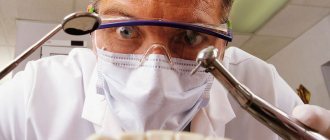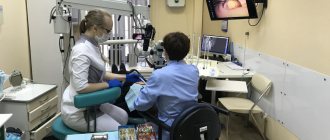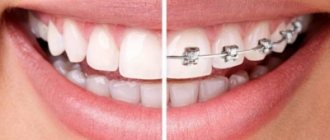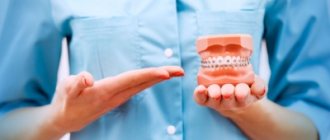Who is a dentist?
Dentist is a unifying definition applied to a dental specialist with higher education. (Stoma, stomatos means mouth in Greek, logos – teaching). To become a dentist, you need to graduate from a medical academy, institute or university.
The duration of their studies is at least 5 years. Along with dental diseases, future dentists study many medical sciences - biochemistry, physiology, therapy, histology, etc.
They are prepared not only theoretically, but also practically, having completed a one-year internship or a 2-year residency.
Orthopedist
Patients who have lost one or more units of dentition turn to this specialist. The doctor will help people who have ugly stumps sticking out instead of teeth, causing injuries to the mucous membrane.
What does an orthopedic dentist do:
- performs full or partial prosthetics;
- restores the beauty of a smile;
- selects the optimal method for normalizing chewing function.
Important! Before consultation with a prosthetist, it is mandatory to sanitize the oral cavity and eliminate inflammatory processes of various etiologies. A visit to the dentist or dental therapist is the first stage of orthopedic treatment.
What is the difference between these concepts?
The difference between a dentist and a dentist is the level of training and the type of treatment they can perform.
The list of works provided for in the job description of a dentist includes:
- A dentist is a general specialist
diagnostics;
- treatment of relatively simple diseases of teeth and gums - gingivitis, stomatitis, caries and some others;
- removal of teeth not complicated by periodontitis;
- treatment of simple maxillofacial injuries.
- carrying out physical procedures;
- consultation regarding the choice of oral hygiene products;
- cleaning teeth from plaque and tartar, and some others.
In case of more serious dental pathologies - malocclusion, pulpitis, periodontitis, periodontal disease, lesions that have caused tooth destruction by more than 50%, and in other cases requiring the participation of a more trained specialist, the dentist gives the patient a referral to a dentist of the appropriate specialization.
A dentist is a general specialist. He has theoretical knowledge and practical skills sufficient to perform therapeutic, orthodontic, orthopedic and surgical operations.
Although, like a dentist, when faced with a particularly difficult case, he can refer the patient to a doctor of a narrow specialization.
conclusions
There are a lot of specialists in dentistry, and the activities of each of them are different. It is important to remember that you can avoid serious oral health problems and trips to dental clinics if you follow the basic rules:
- brush your teeth twice a day;
- visit the dentist once a year, even if there is no reason for this;
- Do not delay your visit if your gums become sensitive or inflamed.
By following these conditions, you will protect yourself from problems in the future. Do not be afraid of doctors; many diseases begin completely asymptomatically, and only a specialist will be able to identify the threat in time.
Narrower specializations
The large number and complexity of pathologies of the dentofacial apparatus, the constant improvement of existing treatment technologies and the development of new ones require in-depth, specific knowledge and skills from dentists.
This feature has found its implementation in the concept of narrow specialization of dentists.
Depending on the type of work performed, the following specializations of dentists differ:
- therapist;
- orthodontist;
- surgeon;
- orthopedist;
- hygienist;
- pediatric dentist.
Dentists often combine several specializations at once.
Dental surgeon
The prerogative of the profession of a dental surgeon is the following operations:
- Dental surgeons often treat diseases that are within the competence of dentists of other specialties
tooth extraction;
- treatment of neoplasms in the PR;
- elimination of TMJ dysfunctions, diseases of the salivary glands and trigeminal nerve;
- primary treatment of wounds and injuries of the mouth, neck, face;
- plastic surgery and reconstruction of jaw bones;
- operations on periodontal tissues (gingivectomy, gum pocket removal, soft tissue transplantations, gingivoplasty, plastic surgery of the oral vestibule and frenulum);
- correction of tooth position anomalies.
- implantation.
Dental surgeons often treat diseases that are within the competence of dentists of other specialties: phlegmon, periodontitis, sinusitis, periostitis, abscesses, osteomyelitis.
They also diagnose specific diseases, the symptoms of which may appear in the PR - syphilis, tuberculosis, actinomycosis.
Dentist-therapist
Typically, patients who seek help from a dentist first see a therapist.
Dental therapist is the broadest specialization in dentistry.
Typically, patients who seek help from a dentist first see a therapist, who in most cases is able to deal with their problem alone.
The job description of a dental therapist provides for the following work:
- examination of the oral cavity;
- diagnosing;
- treatment of teeth (caries, pulpitis, etc.) and periodontal disease (gingivitis, periodontitis, periodontal disease, periodontitis);
- preparation of PR for prosthetics, its sanitation;
- teeth whitening and PG;
- preventive examination and advice on caring for RP.
When pathologies are identified that urgently require the participation of a specialist doctor, the therapist refers the patient to them.
Orthopedist
An orthopedist restores teeth using prosthetics
A doctor of this specialization is engaged in the restoration of dilapidated, missing or lost aesthetic teeth using prosthetics.
Orthopedist:
- takes impressions of teeth, from which the dental technician subsequently makes a prosthesis;
- tries on, adjusts and secures the prosthesis on the patient.
Prosthetic structures include crowns, bridges, inlays, veneers, and removable dentures.
Orthodontist
The orthodontist adjusts the position of teeth using removable and non-removable orthodontic devices
Orthodontics is a subsection of dentistry dedicated to dental anomalies.
The scope of practice of an orthodontist includes:
- prevention of deformations of individual teeth, dentition and jaws;
- normalization of occlusion;
- correction of jaw development;
- teeth straightening.
Correction of the position of teeth is carried out using removable and non-removable orthodontic devices - mouthguards, braces, braces.
Children's teeth at the stage of formation and growth are most successfully corrected. In adults, this process is much more difficult.
General dentist
The specialty “General Dentistry” was introduced by orders of the Ministry of Health No. 553 and 112. This specialty is of particular importance for rural areas, where it is desirable to have a specialist who can provide assistance in several clinical areas.
However, until now, due to a number of organizational, educational and legal problems, general practice in dentistry has not received proper development.
Children's
Children and adolescents under the age of 17 are patients of the pediatric dentist.
A child's teeth have many differences from adult teeth. This includes the presence of baby teeth, the constant renewal and formation of the dentofacial apparatus, and the inability to use certain anesthetics for children.
And the reaction of children to the dental chair creates increased problems.
A dentist treating children must not only be able to distinguish pathology from the age norm, detect deviations in bite and tooth formation in time, but also be a bit of a psychologist.
Hygienist
The goal of a hygienist is to prevent dental diseases
Dental hygienist is a relatively new specialization in dentistry.
Its goal is the prevention of dental diseases, its field of activity is dental hygiene, proper dental care.
A dental hygienist performs the following work:
- diagnosing RP diseases;
- professional teeth cleaning;
- disease prevention;
- training in proper dental care skills;
- educational activities (inspections in kindergartens, schools, institutions, organizations, enterprises).
Surgeon
The specialist deals with the following issues:
- removes diseased teeth if the therapist has given a conclusion that restoration is impossible;
- carries out extraction (removal) of healthy teeth that interfere with the normal growth of neighboring units;
- performs correction of dental anomalies, removal of impacted (unerupted) wisdom teeth, supernumerary units;
- the help of a dental surgeon will be needed if certain units grow incorrectly, for example, in 2 rows;
- The specialist's competence includes implantation and various types of prosthetics.
Categories of dentists
Dentists are required to confirm their qualifications every 5 years
Each dentist has a certain qualification category, which is an indicator of the level of his theoretical knowledge and practical skills.
The procedure for assigning a qualification category is determined by order of the Ministry of Health of the Russian Federation.
Dentists are required to confirm their qualifications every 5 years.
Those who wish to improve their qualifications themselves must wait 3 years from the date of the last certification.
Regulatory documents provide for three types of categories in ascending order:
- second (is basic);
- first;
- highest.
Requirements for various categories:
| Category | Requirements |
| Second | Work experience in the specialty for at least 3 years. Successful completion of certification. |
| First | Work experience in the specialty for at least 7 years. For a specialist with secondary education – at least 5 years. Successful completion of certification. |
| Higher | Work experience in the specialty for at least 10 years. For a specialist with secondary education – at least 7 years. Successful completion of certification. |
Orthodontist
Most people encounter a specialist in this category during their lifetime. Bite anomalies, according to statistics, are observed in 80% of residents of different countries. Some studies suggest a higher percentage of patients who are candidates for orthodontic treatment.
The main task of an orthodontist is to restore the beauty of a smile. According to scientists, bite defects not only worsen aesthetics, but also provoke serious pathologies of the gastrointestinal tract, cause headaches, and severe diseases of the gum and bone tissue.
What does an orthodontist do:
- aligns the dentition;
- eliminates wide interdental spaces, removes diastema - the gap between the “units” in the center of the dentition;;
- corrects the growth of milk and permanent units;
- gives recommendations for the prevention of malocclusions;
- controls the formation of the jaw in childhood.
Take note:
- the specialist draws up a treatment plan, takes impressions, sends the jaws for x-rays, sends the collected materials to the dental laboratory;
- after receiving the finished product, the doctor installs the design, gives recommendations for care and correct correction;
- During the entire period of treatment, the patient is observed by a doctor who installed braces, retainers or other special devices;
- The duration of correction is calculated in months, often years (especially in adults).
Removable and non-removable orthodontic structures help correct bite defects:
- stretching plates;
- bracket systems;
- veneers;
- lumineers;
- orthodontic devices;
- lip bumpers;
- retainers;
- trainers;
- aligners;
- orthodontic aligners;
- clasp devices.
Related materials:
dentist | Givenchy | SEPHORA COLLECTION | Dior | Givenchy | Sephora | Dior | teeth | white teeth | smile | beautiful smile | prosthesis | surgery
Articles
- In the know: fall makeup trends August 29, 2015, 00:00
- Virtual Stylist: The Most Stylish Apps December 17, 2022, 00:00
- Pastel makeup: making accents January 25, 2022, 00:00
Video
- New birth of four-color shadows from Givenchy September 15, 2010, 00:00
- Little tricks for a dazzling smile from Givenchy October 20, 2010, 00:00
- Beauty in Korean October 24, 2016, 12:00
Reviews
- No. 1. Becoming a dentist requires a certain amount of persistence and determination. It took me a total of about 8 years to study, and I didn’t even count how many times I attended various seminars and conferences after receiving my diploma (well, there were already courses twice). I didn’t immediately understand what direction I wanted to work in, and only after the internship I came to the conclusion that I would be a pediatric dentist. Working with such patients is not easy, but there are more positive emotions. After the appointment, I always give my patients some kind of souvenir - soap bubbles or balls with the symbols of our clinic, and on my own behalf - certificates for bravery, I simply print them out on a printer. I work in a private clinic, the salary is 80-90 thousand rubles per month. Our team is good, overall I’m happy with everything.
- No. 2. I myself work as a dental surgeon, and my wife is a dental therapist. When we had the opportunity, we opened our own office. It wasn’t easy, and it wasn’t even a matter of finding clients; we literally lured many away when we left our previous place of work. It’s just that organizing an office is an expensive pleasure, considering all the standards. We try not to raise the markup too much in order to retain customers - the competition is still quite strong, and we set aside part of the money for upgrading equipment, so my monthly salary is 77-80 thousand rubles, my wife gets about the same (75 on average ).
What do you need to know about working in a private clinic and your own office?
Despite the fact that such work brings more income, it is associated with certain nuances that you need to be aware of when choosing a certain type of activity. For example, in a private clinic, doctors must first familiarize themselves with corporate standards; some even introduce a dress code. And when opening your own office, you need to spend a lot of money and time to bring everything into compliance with the standards prescribed in laws and regulations.
Dentist advertising and job search
For a dentist, reputation is very important when looking for a job. Therefore, he can gain experience in a state clinic, so that he will soon be able to receive good recommendations. In addition, there are special professional groups on social networks where dentists can post photographs of their most successful work. This can be considered a kind of self-promotion, so that in the future you can refer to this portfolio during an interview. Of course, photographs need to be protected with watermarks, since such works can simply be stolen.
Working with social media networks
Owners of private accounts can actively promote their services on social networks, but in groups aimed at consumers. For example, you can use Instagram as a tool by tagging relevant hashtags. This technique is considered especially effective for orthodontists who primarily offer aesthetic medicine services.
Work schedule in a private clinic or your own office
Many people believe that private clinics have more flexible hours than public clinics. Actually this is not true. Very often it is scheduled several days in advance and without any “windows”. In addition, many clinics are open six to seven days a week to accommodate those patients who cannot make an appointment on weekdays. But private clinics are good because they have more time to see patients, the doctor can plan a lot himself, and as a result he works at a more comfortable pace.
Pros and cons of the profession
Like any other occupation, this profession has its pros and cons. Its advantages include:
- consistently high demand in the labor market,
- high level of payment,
- good career prospects, especially in science,
- opportunity to open your own business.
However, it also has its drawbacks. This is a great responsibility, and the need to work in a stressful situation, and some monotony of professional activity. Also worth mentioning is the high cost of medical education and further training.










